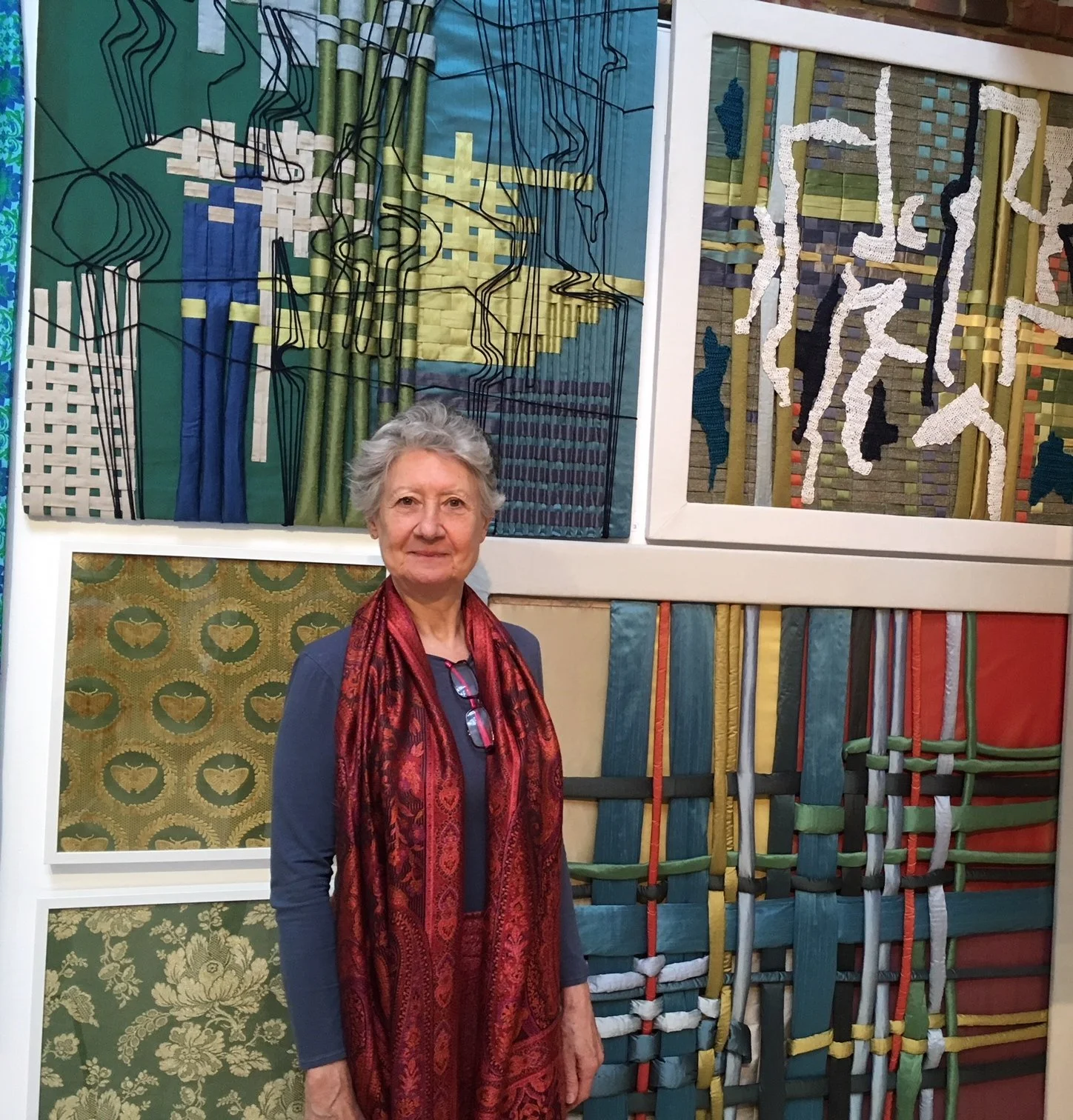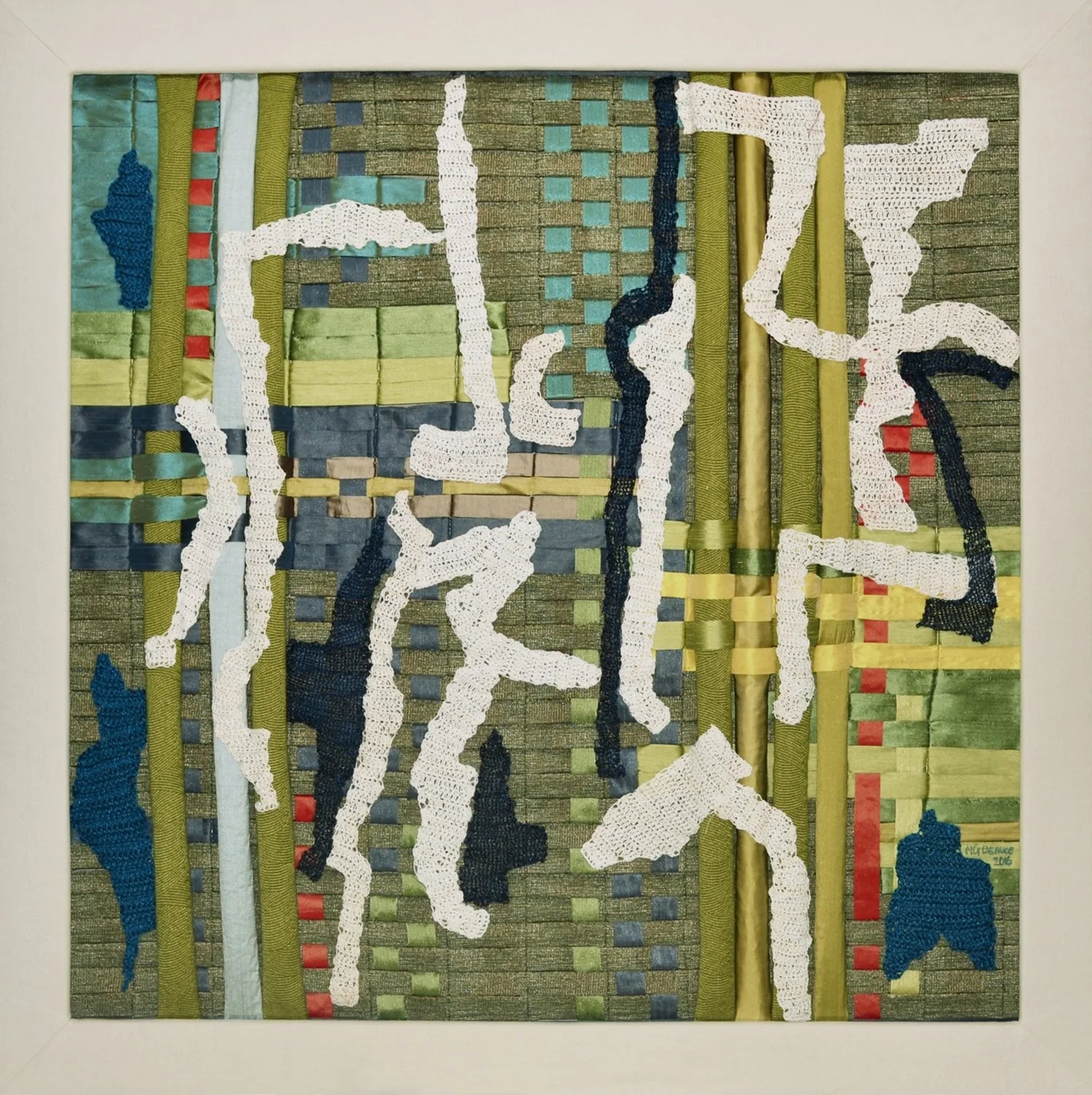Interview with Marie-Ghislaine Beaucé
My name is Marie-Ghislaine Beaucé, a French artist currently active in London. Since 2015, I have been creating works of abstract art using luxury textiles and employing various techniques such as weaving and layering strips of fabrics as well as incorporating crochets knitted elements to add varies textures to the pieces.
Your work beautifully intertwines a variety of textures and materials to create unique abstract spaces. How do you perceive the relationship between the tactile nature of textiles and the often intangible, ethereal quality of abstract art? In what ways do you believe this interplay impacts the viewer's experience of your pieces?
From the simple structure of woven cloth made of vertical and horizontal strands of wool, linen or cotton, geometry and abstraction have been present in art for a long time. I am referring to a painting by the 17th century French artist Nicolas Poussin called “Bacchanals with a lute player” in which the skirt of the sitting female musician clearly shows under a magnifying glass the profound structure and quality of the cloth, making a portion of it a work of abstract art in its own right. In my pieces the intersection of perpendicular lines and the shadows of the thick elements create directions of space and balance leading to serenity.
Reflecting on your lifelong journey with textiles, how has your understanding and approach to these materials evolved from your childhood ambition to become a fashion designer to your current practice as an abstract textile artist? What pivotal moments or experiences have significantly shaped this evolution?
During my technical studies of garment making including pattern cutting and assembling, I attended art classes in the same college. My art teacher then advised me to enter the Ecole Nationale des Beaux-Arts (National School of Fine Arts) which I did in Nantes in the west of France where I was livingat the time. From the 3rd year of the curriculum, each student was invited to engage in working and researching the mode of expression which suited one best; evidently I chose to work with textiles, mainly because the looseness of the weaving allowed me to easily remove some of the weft-yarn to insert pieces of painted cardboard tubes, strips of fabrics, 8mm film, and metal.
At the same period, I had the opportunity to visit an exhibition by the Catalan textile artist Grau-Garriga who was in the foreground among creators, which was then a revelation for me.
Nature's chromatic hues are a significant inspiration in your work. How do you go about capturing the essence of nature within the abstract framework of your art? Can you describe a particular natural scene or element that profoundly influenced a specific piece, and what emotional or sensory experiences you aim to evoke through such inspirations?
I have always been sensible to the tonality and subtlety of natural colours, my favourite season of the calendar year being autumn with its display of rich yellow, copper and red among a palette of green hues. As I do not dye the material myself but use remnants of soft furnishing fabrics, the search for the right colour to incorporate in a piece can sometimes be frustrating. I do not try to be influenced by nature although some of my works tend to prove the contrary; for “Tissage 4” I took my inspiration from one of my early abstract designs made of gouache and coloured inks on tissue paper. My aim is to provide a sense of calm and beauty from the works containing natural tonalities.
Your artistic process involves intricate layering of fabrics to create depth and texture. How do you navigate the conceptual and practical challenges of balancing the two-dimensionality of fabrics with the three-dimensionality of padded tubes and other elements? What does this layered depth represent in your broader artistic narrative?
To give full flight to my inspiration I need materials and relief. The use of fabrics with varied composition and texture allows me to play on contrast, passing from the sheen of silk or velvet to the mat rough texture of thick linen and cords. The challenge of combining thick padded tubes with thinner ones is a tricky one as in “Tissage 2”, where the padded elements are knotted and intertwined, resulting in depth and shadows upon the intricate weaving of the background, wanting the viewer to reflect upon space and serenity of the carefully balanced piece.
Your panels are described as hybrids between patchwork and plasticism. How do you define the boundaries between these two art forms, and what unique possibilities do you believe emerge from their intersection? In what ways does this hybrid nature reflect or challenge traditional notions of textile art and abstraction?
I think it is really difficult to define boundaries between patchwork and plasticism, and I find the intellectual possibilities not so engaging for myself personally.
Receiving prestigious awards like the Global Art Virtuoso Award and the International Prize Botticelli is a testament to your impact in the art world. How do these recognitions influence your creative process and your perception of your work? Do they introduce new pressures or opportunities that shape the direction of your art?
I am very honoured to have been awarded the Global Art Virtuoso Award, The International Prize Botticelli, as well as the International Prize Leonardo Da Vinci and the International Prize Phoenix this year. These recognitions engage me to persevere in this highly competitive global art market whilst maintaining my original creativity.
Vincenza Ursillo describes your work as representing a "large mysterious space" far from reality. How do you conceptualize and create this enigmatic space within your art? What themes or ideas are you exploring through this abstraction, and how do you hope your audience interprets or engages with this mysteriousness?
I think Vincenza Ursillo refers to the space created by the physical depth of the constituting elements and the mysterious shadows occurring under moving or different lighting as well as the relationship between the classic weaving of the background and the soft vibration of the foreground in relief. Although some pieces carry complexity in their visual effect by the juxtaposition of mixed techniques, I hope that for my audience they convey a sense of calm and beauty, discovering hidden paths to serenity.
Your career began with an aspiration to fashion design, which evolved into a distinct path in textile art. What elements from your early fashion design aspirations continue to resonate in your current work? How do you integrate principles of design, texture, and color from the fashion world into your abstract art practice?
In some of my work, “Tissage 5” for example, I inserted piping and pompoms made of fabrics which are elements of fashion design. In other works, I used bias binding in contrasting colours to enhance the structure of the design. In my artwork I refuse to use “trendy” colours concentrating on the ones I am comfortable with, sometimes adding experimentation.
In describing your work, Ruthie Tucker highlights the spiritual integration of your artistic vision into the textile medium. How do you view the spiritual or emotional dimensions of your art? Can you share an example of how a specific piece embodies this integration, and what you hope viewers gain on a deeper, perhaps subconscious level?
It is very interesting to hear eminent authorities in the Art world describing one’s artwork as containing a spiritual dimension. Ruthie Tucker applied that description in the press release of the “Chelsea Connoisseurs” exhibition. However, not being drawn to spirituality myself, I don’t consciously bring it into my work.
The interplay of light and texture is a prominent feature in your tapestries, creating luminous and textured effects. How do you approach the manipulation of these elements during your creative process? Can you elaborate on a particular work where the use of light and texture was central to its creation and the impact you intended to achieve?
Most of the time, each work is a translation from one of my original designs. But it can be the case as with the three works of the “Rhapsody” suite, that the translation is the result of an inner vision of each piece. Before starting on a piece, I carefully determine the fabrics and materials I will be using for that particular work. I choose fabrics with interesting textures like velvet for example, although it is notoriously difficult to work with, or jacquard weaving. If the chosen fabrics are too plain, I have recourse to varied styles of weaving to bring light and depth to the ensemble.


















